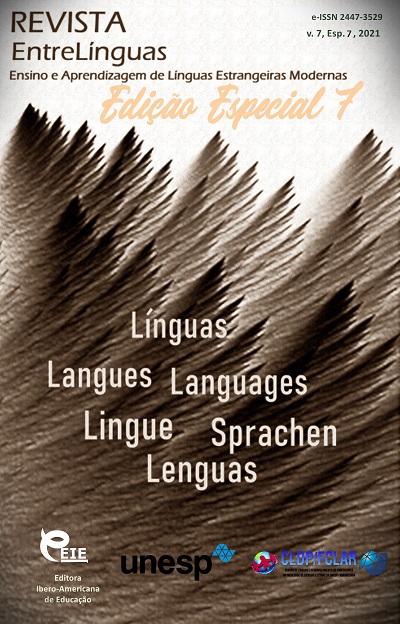Semántica comparativa en paroemias francesas
DOI:
https://doi.org/10.29051/el.v7iesp.7.16303Palabras clave:
Paroemia, Comparación, Estructura semántica, Metáfora, Metonimia, IsotopíaResumen
Este artículo presenta un análisis del sistema de paroemias con semántica comparada de la lengua francesa. La estructura de las paroemias se estudia tanto desde la perspectiva de su especificidad lingüística como desde la semántica interpretativa. El espacio comparativo de la paroemia francesa está representado por construcciones comparativas y, en mayor medida, por cláusulas de identidad sin conjunción, sugiriendo una naturaleza analítica de la estructura sintáctica de las paroemias francesas. Varios tipos de construcciones comparativas dentro de las paroemias francesas no solo son elementos compositivos, sino también semánticos de los proverbios. En ellos se realizan diversas relaciones lógicas que se encuentran no sólo en comparación o yuxtaposición, sino también en oposición dentro del marco de la comparación negativa. El aspecto linguopragmático de las paroemias es que los refranes alotópicos (incoherentes), a primera vista, actúan como secuencias isotópicas después de la actualización de características aferentes comunes, que, por regla general, están codificadas socialmente. Las paroemias francesas con semántica comparada se caracterizan por una figuración completa, basada en la metaforización de uno o más componentes, o en la contigüidad. Así, los componentes de las paroemias estudiadas aparecen con un significado adecuado y necesitan ser decodificados, ya que a menudo establecen la identidad entre dos ideas incompatibles.
Descargas
Citas
ANDRIANOVA, N.S., OSTROUMOVA, O.F., & ABDULMIANOVA, I.R. Representation of «war» concept by phraseological means of Russian language. Herald NAMSCA, 3, 724-727. 2018.
BOLGAROVA, R.M., SAFONOVA S.S., & ZAMALIUTDINOVA E.R. Comparison in Russian and Tatar linguocultures: systemic functional and comparative analysis. Journal of Language and Literature, 5(3), 148-152. 2014.
FATTAKHOVA, N., & KULKOVA, M. The Formation of Paroemiology in Russia and Germany. World Applied Sciences Journal, 31(5), 935-939. 2014.
GOLOVIN, А.S. Linguocultural Concept of “Kinship” in English, German and Russian Paroemias: Dissertation for Candidate of Philology. Moscow State Pedagogical University. Moscow, 146 p. 2014.
GURYANOV, I., RAKHIMOVA, A., & RUDNICK, A. Socio-cultural aspect of coloristic components of idioms in German discourse. Revista QUID (Special Issue), 800-805. 2017.
KOGUT, V.I. Proverbes et dictons de France et leurs équivalents russes: French Proverbs and Sayings and Their Russian Equivalents: The Dictionary of French Proverbs and Sayings. SPb.: The “Anthology” Publishing, 240 p. 2016.
Le Petit Larousse illustré. Larousse, 1818 p. 2010.
NABIULLINA, G.A., DENMUKHAMETOVA E.N., & MUGTASIMOVA G.R. The linguistic characteristics of Tatar Paroemiae”, Life Science Journal, 11(5), 559-562. 2014.
NIKOLAYEVA, Е.К. Set Comparisons in Russian Proverbs. The Problems of History, Philology, Culture, 3, 238-243. 2010.
SAVENKOVA, L.B. Negative Comparison in Semantic Structure of Russian Paroemias. Philology and Culture, 2(40), 101-106. 2015.
YASYUKEVICH, Е.N. Types of Paroemia Imagery (The Case Study of Russian and English Proverbs)”, The Herald of BSU. Series 4. Philology. Journalism. Pedagogics, 1, 49-53. 2002.
ZAMALETDINOVA, G., KONDAKOVA, I., SHUSTOVA, S., & GAFIYATOVA, E. Place-name metaphor in English and Russian. Revista QUID (Special Edition), 806-811. 2017.
Descargas
Publicado
Cómo citar
Número
Sección
Licencia

Esta obra está bajo una licencia internacional Creative Commons Atribución-NoComercial-CompartirIgual 4.0.
Os manuscritos aceitos e publicados são de propriedade da Revista EntreLínguas. Os artigos publicados e as referências citadas na Revista EntreLínguas são de inteira responsabilidade de seus autores.
Transferência de direitos autorais – autorização para publicação
Caso o artigo submetido seja aprovado para publicação, já fica acordado que o(s) autor(es) autoriza(m) a UNESP a reproduzi-lo e publicá-lo na EntreLínguas, entendendo-se os termos “reprodução” e “publicação” conforme definição respectivamente dos incisos VI e I do artigo 5° da Lei 9610/98. O artigo poderá ser acessado pela rede mundial de computadores (Internet), sendo permitidas, a título gratuito, a consulta e a reprodução de exemplar do artigo para uso próprio de quem a consulta, desde que haja a citação ao texto consultado. Essa autorização de publicação 328 EntreLínguas, Araraquara, v. 1, n .2, p. 323-328, jul./dez. 2015 não tem limitação de tempo, ficando a UNESP responsável pela manutenção da identificação do(s) autor(es) do artigo. Os artigos publicados e as referências citadas na Revista EntreLínguas são de inteira responsabilidade de seus autores.











